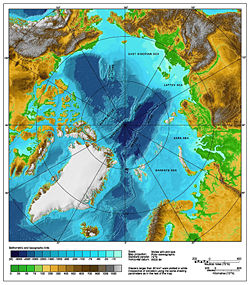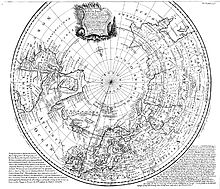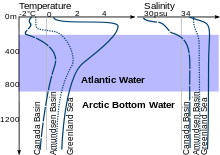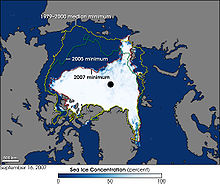
Arctic Ocean
Did you know...
SOS Children has tried to make Wikipedia content more accessible by this schools selection. Child sponsorship helps children one by one http://www.sponsor-a-child.org.uk/.
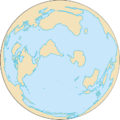 |
| Earth's oceans |
|---|
|
World Ocean |
The Arctic Ocean, located in the Northern Hemisphere and mostly in the Arctic north polar region, is the smallest and shallowest of the world's five major oceanic divisions. The International Hydrographic Organization (IHO) recognizes it as an ocean, although some oceanographers call it the Arctic Mediterranean Sea or simply the Arctic Sea, classifying it a mediterranean sea or an estuary of the Atlantic Ocean. Alternatively, the Arctic Ocean can be seen as the northernmost part of the all-encompassing World Ocean.
Almost completely surrounded by Eurasia and North America, the Arctic Ocean is partly covered by sea ice throughout the year (and almost completely in winter). The Arctic Ocean's temperature and salinity vary seasonally as the ice cover melts and freezes; its salinity is the lowest on average of the five major oceans, due to low evaporation, heavy freshwater inflow from rivers and streams, and limited connection and outflow to surrounding oceanic waters with higher salinities. The summer shrinking of the ice has been quoted at 50%. The US National Snow and Ice Data Centre (NSIDC) uses satellite data to provide a daily record of Arctic sea ice cover and the rate of melting compared to an average period and specific past years.
History
For much of European history, the North Polar regions remained largely unexplored and their geography conjectural. Pytheas of Massilia recorded an account of a journey northward in 325 BC, to a land he called " Eschate Thule," where the Sun only set for three hours each day and the water was replaced by a congealed substance "on which one can neither walk nor sail." He was probably describing loose sea ice known today as " growlers" or "bergy bits;" his "Thule" was probably Norway, though the Faroe Islands or Shetland Island have also been suggested.
Early cartographers were unsure whether to draw the region around the North Pole as land (as in Johannes Ruysch's map of 1507, or Gerardus Mercator's map of 1595) or water (as with Martin Waldseemüller's world map of 1507). The fervent desire of European merchants for a northern passage to " Cathay" (China) caused water to win out, and by 1723 mapmakers such as Johann Homann featured an extensive "Oceanus Septentrionalis" at the northern edge of their charts.
The few expeditions to penetrate much beyond the Arctic Circle in this era added only small islands, such as Novaya Zemlya (11th century) and Spitsbergen (1596), though since these were often surrounded by pack-ice, their northern limits were not so clear. The makers of navigational charts, more conservative than some of the more fanciful cartographers, tended to leave the region blank, with only fragments of known coastline sketched in.
This lack of knowledge of what lay north of the shifting barrier of ice gave rise to a number of conjectures. In England and other European nations, the myth of an " Open Polar Sea" was persistent. John Barrow, longtime Second Secretary of the British Admiralty, promoted exploration of the region from 1818 to 1845 in search of this.
In the United States in the 1850s and 1860s, the explorers Elisha Kane and Isaac Israel Hayes both claimed to have seen part of this elusive body of water. Even quite late in the century, the eminent authority Matthew Fontaine Maury included a description of the Open Polar Sea in his textbook The Physical Geography of the Sea (1883). Nevertheless, as all the explorers who travelled closer and closer to the pole reported, the polar ice cap is quite thick, and persists year-round.
Fridtjof Nansen was the first to make a nautical crossing of the Arctic Ocean, in 1896. The first surface crossing of the ocean was led by Wally Herbert in 1969, in a dog sled expedition from Alaska to Svalbard, with air support. The first nautical transit of the north pole was made in 1958 by the submarine USS Nautilus, and the first surface nautical transit occurred in 1977 by the icebreaker NS Arktika.
Since 1937, Soviet and Russian manned drifting ice stations have extensively monitored the Arctic Ocean. Scientific settlements were established on the drift ice and carried thousands of kilometres by ice floes.
Geography
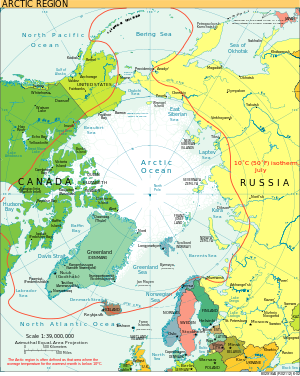
The Arctic Ocean occupies a roughly circular basin and covers an area of about 14,056,000 km2 (5,427,000 sq mi), almost the size of Russia. The coastline is 45,390 km (28,200 mi) long. It is surrounded by the land masses of Eurasia, North America, Greenland, and by several islands.
It is generally taken to include Baffin Bay, Barents Sea, Beaufort Sea, Chukchi Sea, East Siberian Sea, Greenland Sea, Hudson Bay, Hudson Strait, Kara Sea, Laptev Sea, White Sea and other tributary bodies of water. It is connected to the Pacific Ocean by the Bering Strait and to the Atlantic Ocean through the Greenland Sea and Labrador Sea.
Extent and major ports
There are several ports and harbors around the Arctic Ocean
Alaska
In the Alaska (US) the main ports are Barrow ( 71°17′44″N 156°45′59″W) and Prudhoe ( 70°19′32″N 148°42′41″W).
Canada
In Canada, ships may anchor at Churchill ( 58°46′09″N 94°10′9″W), Inuvik ( 68°21′42″N 133°43′50″W), Nanisivik ( 73°2′5″N 84°32′13″W) in Nunavut or at Tuktoyaktuk ( 69°26′34″N 133°1′52″W).
Norway
In Norway Kirkenes ( 69°43′N 30°03′E) and Vardø ( 70°22′14″N 31°6′27″E) are ports on the main land. Also, there is Longyearbyen ( 78°13′12″N 15°39′0″E) on the island Svalbard next to Fram Strait.
Russia
In Russia, major ports sorted by the different sea areas are
- Murmansk ( 68°58′N 33°5′E) in the Barents Sea
- Arkhangelsk ( 64°32′N 40°32′E) in the White Sea
- Labytnangi ( 66°39′26″N 66°25′06″E) Salekhard ( 66°32′N 66°36′E), Dudinka ( 69°24′N 86°11′E), Igarka ( 67°28′N 86°35′E) and Dikson ( 73°30′N 80°31′E) in the Kara Sea
- Tiksi ( 71°38′N 128°52′E) in the Laptev Sea
- Pevek ( 69°42′N 170°17′E) in the East Siberian Sea
Shelves
The Arctic Ocean is encompassed by a number of continental shelves, including that of Canada and the Continental shelf of Russia, which consists of three separate, smaller shelves, the Barents, Chukchi and Siberian. Of these three, the Siberian Shelf is the largest such shelf in the world. The Siberian Shelf holds large oil and gas reserves, and the Chukchi shelf forms the border between Russian and the United States as stated in the USSR–USA Maritime Boundary Agreement.
Underwater features
An underwater ridge, the Lomonosov Ridge, divides the deep sea North Polar Basin into two oceanic basins: the Eurasian Basin, which is between 4,000 and 4,500 m (13,000 and 14,800 ft) deep, and the Amerasian Basin (sometimes called the North American, or Hyperborean Basin), which is about 4,000 m (13,000 ft) deep. The bathymetry of the ocean bottom is marked by fault-block ridges, abyssal plains, ocean deeps, and basins. The average depth of the Arctic Ocean is 1,038 m (3,406 ft). The deepest point is in the Eurasian Basin, at 5,450 m (17,880 ft).
The two major basins are further subdivided by ridges into the Canada Basin (between Alaska/Canada and the Alpha Ridge), Makarov Basin (between the Alpha and Lomonosov Ridges), Fram Basin (between Lomonosov and Gakkel ridges), and Nansen Basin ( Amundsen Basin) (between the Gakkel Ridge and the continental shelf that includes the Franz Josef Land).
Oceanography
Water flow
The Arctic Ocean contains a major choke point in the southern Chukchi Sea, which provides access to the Pacific Ocean through the Bering Strait between Alaska and Eastern Siberia. Subject to ice conditions, the Arctic Ocean provides the shortest marine link between the extremes of eastern and western Russia. There are several floating research stations in the Arctic, operated by the U.S. and Russia.
The greatest inflow of water comes from the Atlantic by way of the Norwegian Current, which then flows along the Eurasian coast. Water also enters from the Pacific via the Bering Strait. The East Greenland Current carries the major outflow.
Ice covers most of the ocean surface year-round, causing subfreezing air temperatures much of the time. The Arctic is a major source of very cold air that moves toward the equator, meeting with warmer air at latitude 60°N and causing rain and snow. This flow is the lower portion of the polar cell, the highest (by latitude) of the three principal circulation cells of the Earth's atmosphere each spanning thirty degrees of latitude. Marine life abounds in open areas, especially the more southerly waters. The ocean's major ports are the cities of Murmansk, Arkhangelsk and Prudhoe Bay.
Arctic Water Masses
In large parts of the Arctic Ocean, the top layer (about 50 m) is of lower salinity and lower temperature than the rest. It remains relatively stable, because the salinity effect on density is bigger than the temperature effect. It is fed by the freshwater input of the big Siberian and Canadian streams (Ob, Yenissey, Lena, MacKenzie), the water of which quasi floats on the saltier, denser, deeper ocean water. Between this lower salinity layer and the bulk of the ocean lies the so-called halocline, in which both salinity and temperature are rising with increasing depth.
Any convection eddies caused by the temperature difference between the cold ocean surface and the warmer depth stop at this thermocline, leaving only heat conduction as upward heat transport mechanism, which is orders of magnitude smaller. Without this insulation effect, there would be much less Arctic sea ice. The salinity and temperature pattern of the Arctic Ocean can be quite complex, being dependent on the different flows into and out of the Arctic region.
Sea ice
Much of the Arctic Ocean is covered by sea ice which varies in extent and thickness seasonally. The mean extent of the ice is decreasing since 1980 from the average winter value of 15,600,000 km2 (6,023,200 sq mi) at a rate of 3% per decade. The seasonal variations are about 7,000,000 km2 (2,702,700 sq mi) with the maximum in April and minimum in September. The sea ice is affected by wind and ocean currents which can move and rotate very large areas of ice. Zones of compression also arise, where the ice piles up to form pack ice.
Icebergs occasionally break away from northern Ellesmere Island, and icebergs are formed from glaciers in western Greenland and extreme northeastern Canada. These icebergs pose a hazard to ships, most famously the Titanic. Permafrost is found on most islands. The ocean is virtually icelocked from October to June, and ships are subject to superstructure icing from October to May. Before the advent of modern icebreakers, ships sailing the Arctic Ocean risked being trapped or crushed by sea ice (although the Baychimo drifted through the Arctic Ocean untended for decades despite these hazards).
Climate
Under the influence of the present ice age, the Arctic Ocean is contained in a polar climate characterized by persistent cold and relatively narrow annual temperature ranges. Winters are characterized by continuous darkness ( polar night), cold and stable weather conditions, and clear skies; summers are characterized by continuous daylight ( midnight sun), damp and foggy weather, and weak cyclones with rain or snow
The temperature of the surface of the Arctic Ocean is fairly constant, near the freezing point of seawater. Because the Arctic Ocean consists of saltwater the temperature must reach −1.8°C before freezing occurs. The density of sea water, in contrast to fresh water, increases as it nears the freezing point and thus it tends to sink. It is generally necessary that the upper 100–150 meters of ocean water cools to the freezing point for sea ice to form. In the winter the relatively warm ocean water exerts a moderating influence, even when covered by ice. This is one reason why the Arctic does not experience the extreme temperatures seen on the Antarctic continent.
There is considerable seasonal variation in how much pack ice of the Arctic ice pack covers the Arctic Ocean. Much of the Arctic ice pack is also covered in snow for about 10 months of the year. The maximum snow cover is in March or April — about 20 to 50 cm (7.9 to 20 in) over the frozen ocean.
The climate of the Arctic region has varied significantly in the past. As recently as 55 million years ago, during the Paleocene–Eocene Thermal Maximum, the region reached an average annual temperature of 10–20 °C (50–68 °F). The surface waters of the northernmost Arctic ocean warmed, seasonally at least, enough to support tropical lifeforms requiring surface temperatures of over 22 °C (72 °F).
Animal and plant life

Endangered marine species in the Arctic Ocean include walruses and whales. The area has a fragile ecosystem which is slow to change and slow to recover from disruptions or damage. Lion's mane jellyfish are abundant in the waters of the Arctic, and the banded gunnel is the only species of gunnel that lives in the ocean.
The Arctic Ocean has relatively little plant life except for phytoplankton. Phytoplankton are a crucial part of the ocean and there are massive amounts of them in the Arctic, where they feed on nutrients from rivers and the currents of the Atlantic and Pacific oceans. During summer, the Sun is out day and night, thus enabling the phytoplankton to photosynthesize for long periods of time and reproduce quickly. However, the reverse is true in winter where they struggle to get enough light to survive.
Environmental concerns
The Arctic ice pack is thinning, and in many years there is also a seasonal hole in the ozone layer. Reduction of the area of Arctic sea ice reduces the planet's average albedo, possibly resulting in global warming in a positive feedback mechanism. Research shows that the Arctic may become ice free for the first time in human history by 2040.
Warming temperatures in the Arctic may cause large amounts of fresh meltwater to enter the North Atlantic, possibly disrupting global ocean current patterns. Potentially severe changes in the Earth's climate might then ensue.
Other environmental concerns relate to the radioactive contamination of the Arctic Ocean from, for example, Russian radioactive waste dump sites in the Kara Sea and Cold War nuclear test sites such as Novaya Zemlya.

